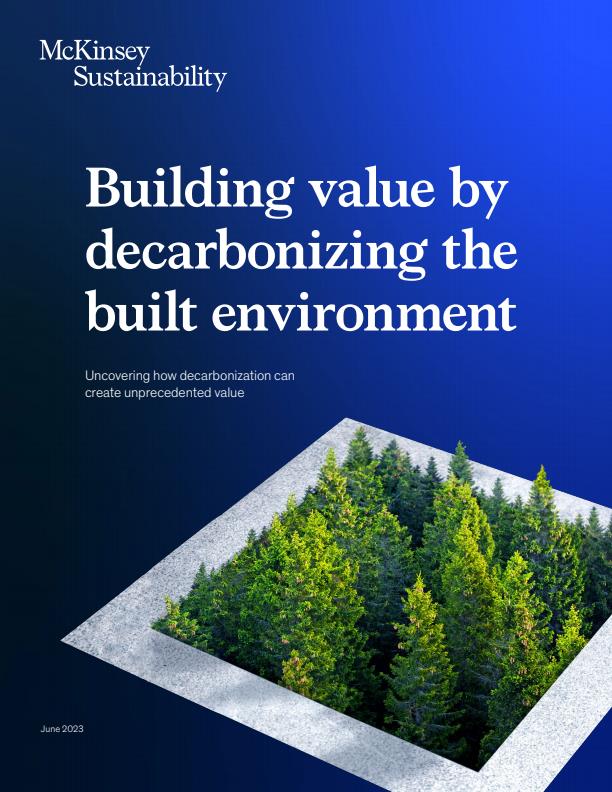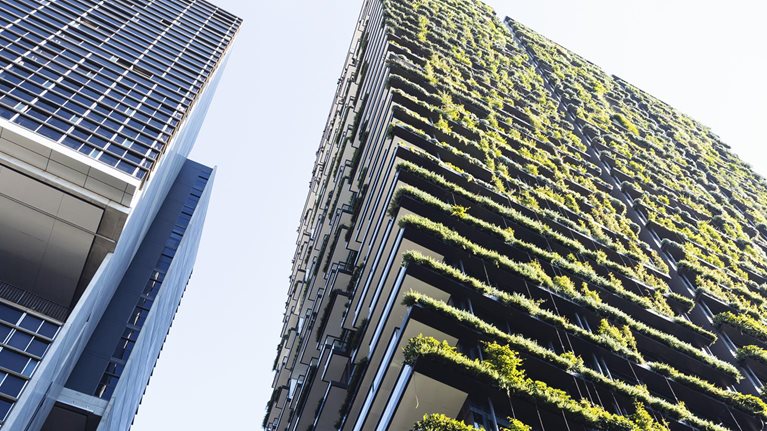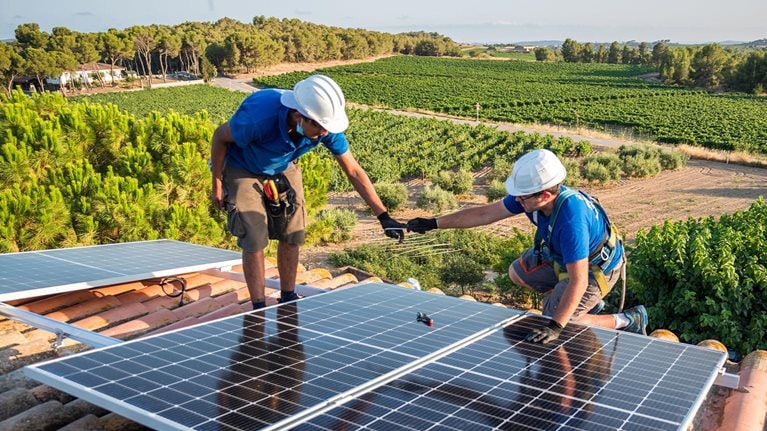The built environment ecosystem consists of real estate and infrastructure and touches all aspects of human life, from homes and offices to factories and highways. It is also responsible for about of a quarter of the world’s greenhouse-gas (GHG) emissions.
To help industry players make progress toward decarbonization, “Building value by decarbonizing the built environment” assesses the most effective solutions available today. Our analysis shows that many levers not only have proven abatement potential but also are already cost-effective. In other words, companies across the built-environment ecosystem could derive value immediately from these less-emissive technologies and solutions.
Further decarbonization levers would be cost-effective by 2030 if they are industrialized—that is, produced and implemented at scale with a focus on quality, cost, and time to market. Because today’s value chains are often fragmented and localized, industrialization poses its own challenge. However, those that act now will likely be able to take advantage of powerful new business opportunities as global decarbonization gains traction. This report identifies 17 such opportunities that could prove particularly attractive for industry players.
Together, the 22 levers we highlight can potentially reduce overall emissions from the built environment by up to 75 percent if implemented at scale in the next five to ten years. In these efforts, all companies in the ecosystem can have significant roles to play. By creating partnerships and focusing their efforts and investments, ecosystem players can find mutually beneficial ways forward while building a net-zero world.
About the analysis
To find the most effective solutions to reduce emissions, we analyzed more than 1,000 levers for their abatement potential, cost-effectiveness, and scalability. Out of these, we selected the most promising levers for more rigorous examination. This involved comparing their impact and technical applicability across six asset archetypes: single- and multifamily dwellings, commercial low- and high-rise buildings, industrial buildings, and infrastructure. These archetypes represent about three-quarters of the built environment.
For each archetype, the net cost of applicable levers was compared with the cost of traditional practices. Levers were considered both as they exist today and if they were to be applied at scale. Finally, each lever was assessed across four geographies and two climate zones to determine if regionally specific factors, such as climate and regulatory differences, affected net cost.
Notably, we did not consider changes in regulatory and policy frameworks when assessing costs and business opportunities for given levers. Although regulatory incentives could create tailwinds for adoption, this report does not take the impact of these factors into account to emphasize that significant progress can be made solely through actions by ecosystem players today.
A serious challenge
Because the built environment encompasses the whole planet, the movement toward its decarbonization needs to be global in scope. The built environment accounts for 14.4 metric gigatons of carbon dioxide equivalent (GtCO2e) of emissions around the world annually (Exhibit 1). Approximately 26 percent of all GHG emissions and 37 percent of combustion-related emissions come from the construction and operation of the built environment.

Emissions come from all phases of the construction process, from carbon-intensive material production processes and suboptimal technology choices to inefficient building designs, construction practices, and energy use after projects are completed. These emissions can be grouped into operational emissions (related to operating and maintaining buildings and structures) and embodied emissions (related to producing and transporting building materials and constructing buildings and structures).
Although many solutions already exist to abate both operational and embodied emissions, the clock is ticking on their implementation. Operational emissions are constantly being released from already-built construction, and once embodied emissions are released, they can only be offset, not abated.
Industrializing solutions that work
All areas of the built environment can benefit from decarbonization, and some have particularly powerful abatement options. For example, on average, space heating and water heating emissions compose roughly three-quarters of operational emissions for residential buildings, making them an excellent target for decarbonization (Exhibit 2). According to our analysis, a single lever—heat pumps—can reduce these emissions by about 60 percent. This and many other effective levers are already cost neutral relative to conventional solutions. Even more levers are expected to be cost neutral or marginally more expensive by 2030 if they can be scaled.

In this report, we found that 22 levers had particularly strong potential due to their high abatement potential, cost-effectiveness, and applicability across archetypes and regions. These levers can reduce operational emissions by up to 90 percent and embodied emissions by up to 60 percent for most of the built environment.1 However, a number of potentially effective levers face a central challenge: industrialization. No matter their abatement potential, if decarbonization levers and solutions cannot be produced and implemented at scale, ecosystem players will not be able to realize their full impact.
To industrialize decarbonization solutions, players will likely need to address challenges in the ecosystem that could deter their widespread adoption. The built environment may span the globe, but it varies widely at a local level and throughout the value chain. Players are often regional, overlapping, and varied in their objectives and business models. In addition, the established industry practices that do exist can be difficult to change. Since many of the solutions are relatively new or unconventional for the industry, industry players may lack awareness of the abatement benefits and economic potential of certain levers, and financial institutions and insurers can be hesitant to support their deployment. Industry players may also face shortages of both labor and materials during the next five to ten years as value chains scale, though our analysis of the most impactful levers is not constrained by these potential shortages.
Despite these challenges, there are many incentives to industrialize decarbonization levers. Industrialization is likely to reduce input costs in several ways. For instance, by establishing procurement best practices, players can develop consistent supply chains and find efficiencies in transportation and in purchasing. An industrialized ecosystem can also enable technicians to gain skills and experience to drive process efficiencies. Increasing the number of units produced can reduce capital expenditures per unit, and the stable customer demand created by a steadier, cost-effective supply of sustainable options can decrease risk and financing costs.
How businesses can unlock value through decarbonization opportunities
Early movers that are able to lead industrialization and commercial adoption of decarbonization solutions are likely to create and capture value from this transition. Among the hundreds of possible business opportunities in decarbonizing the built environment, we have highlighted 17 that could deliver significant value for ecosystem players (Exhibit 3). Industry incumbents and disruptors could act upon these opportunities to accelerate adoption, application, and scaling of levers before 2030.

The value-generating potential of these levers extends across the entire built-environment ecosystem, from real estate owners and developers, to investors, construction companies, material manufacturers, and design and engineering firms. Capturing these opportunities could require industry players to assess their existing capabilities, design future potential operating models, and build green businesses to develop new capabilities. For instance, engineering, procurement, and construction (EPC) firms have an opportunity to design, develop, and implement carbon capture, utilization, and storage (CCUS) solutions for cement plants and high-emitting industrial clusters. And real estate developers, investors, and financiers can generate value by turning existing assets into green assets and setting specifications for green solutions and materials to drive offtake.
For many of these opportunities, players should consider acting together to realize maximum value. Collaboration across the value chain will likely be critical for success, even among competitors. For example, multiple real estate companies could collectively commit to procuring and installing low-carbon building materials, technologies, and services, thereby creating demand, increasing cost competitiveness through scale, and enabling investments thanks to reduced commercial risk.
In addition to horizontal collaboration, players in the built-environment ecosystem will likely need to create partnerships vertically throughout the value chain. Both new and incumbent manufacturers of materials and technologies (such as low-carbon insulation and engineered wood) can adopt best practices regarding process decarbonization and commercialization. They can also proactively approach and educate real estate developers to create demand. To support these decarbonization efforts, investors and financiers could identify high-potential suppliers and partner with forward-leaning real estate players to develop and provide competitive financing solutions.
The need to decarbonize the built environment is urgent, and significant progress can be made with technologies, materials, and solutions that are available today and are proven to have strong decarbonization potential. If ecosystem players can move quickly to assess which green businesses to build or fund, which business models could help create scale, and which partnerships would be beneficial, they are likely to capture economic benefits from opportunities that are executable in the near term.



